It’s getting harder and harder this SEO thing. And it’s not even the fact that the game and it’s Google-enforced rules continue to change. That’s the least of your worries…
How about the scary statistic that there are over a billion websites on the internet, with new sites being added just about every second of the day. That’s more and more people competing for your customers attention and that all important search traffic.
Those same people are competing for backlinks, and with so much free information available most of them know how to get them. (Or they have the money to hire someone who does)
Once upon a time you could build links from anywhere and everywhere and fast-track your way up the search rankings. But unless you are building QUALITY links, from RESPECTED domains to EXCEPTIONAL content – eventually Google will find you out. They will find you out, and as quickly as you rise to the top, you’ll be left in the dust pile with everyone else on page 10.
So should you just give up?
With every scary statistic, there is a flip side – A positive interpretation of the opportunities that lie ahead for marketers just like you and me. So here’s my flip side: more websites might mean more content for you to compete with, but most of it will be MEDIOCRE.
In fact, the ever-increasing mountain of crap content being regurgitated is quite amusing.
“Let’s blog because we have to”
“Oh no wait, let’s start a podcast now…”
“Hold on, I think a new social network just came out let’s do that instead”
If everyone could just take a breath for a moment, forget about the shiny distracting objects and concentrate on helping their customers, building authority and making a difference – We’d all be better for it.
But I’m not here to rant and rave about why so many people are getting it wrong, I’m here to help YOU. If you want more traffic, better rankings and brand authority – the whole shebang –there is no need to get overwhelmed.
The good news for you and me is that whilst there is more and more competition, most people are too lazy, distracted or ill-informed to do it well. So you have an opportunity.
What does this all have to do with SEO?
Ok… Now that my rant is over, let’s get back to why you’re here in the first place. You want to get more traffic, and the most sustainable way to do that is by ranking your content in search engines. To start getting your content to rank, you need backlinks. (Google just re-confirmed this). And quality backlinks are hard to come by, especially if you’re a little unsure on where to start.
Today I want to share an overview of the backlink strategy we teach in our Anchor Content Course. The essence of the whole strategy is to find the type of people who are MOST likely to link to your content, and then persuade them to do so.
There are three potential targets for attracting backlinks to your content:
-
Previous linkers
-
Guest bloggers
-
Round up authors
Before that, let’s do some research
Before I reveal the three types of people that will backlink to your content, let’s talk about finding “content opportunities”. Content opportunities are when a topic, or search term, has the following:
-
Decent search volume, to make it worthwhile
-
Underdone or outdated content, that you can improve on
-
Despite the content generally being below average, it has a nice level of engagement and links
If you can find some red-hot content opportunities, and create quality content to fulfil the exact user intent of these searches, the backlinks will be much easier to get. Finding content opportunities would make for a whole blog post on its own, so I won’t get distracted…
But this simple process is a good place to start:
-
Identify 4 or 5 core problems you solve for your ideal customer
-
Find a list of keywords (primary and long-tail) based on those problems, that get enough search volume (Use Google AdWords or Keyword.io)
-
Search for each potential keyword in a Google search to see what the current content is like, and how much engagement it has
-
Pick something and run with it
Also, for this to work your content needs to be better than anything else out there on your chosen topic. It needs to be anchor style content that is definitive, one-of-a-kind and blows everything else out of the the water. (Or off page one in this case). Like this post from Siege Media:

So if you’re willing to put in the hard yards to find content opportunities, and then create something worth promoting, you can start to think about getting backlinks to it. But don’t bother if you are throwing another mediocre piece of content together just like everyone else. If you’re ready, let’s take a closer look at each one of the potential backlink groups.
Bonus: If you want to create content that will rank in search engines, download the SEO Content Bundle. It is made up of two checklists that will help you create Anchor Content for your website, AND a PDF info sheet that summarizes your SEO Strategy.
Group 1: Previous linkers
So who are these “Previous linkers”? These are people that have written content on their own website (or someone else’s) and linked to content on the same topic you are writing about. They have linked to your ‘keyword competitors’, to put it in another way.
The reason we want to find these people, is because they have linked to similar articles in the past – which means they are likely to do so again if you have high quality content. Here’s how you find them:
Step 1: Find other content on your chosen topic
Now that you know what you want to write about, and you’ve found the relevant keywords, this step is pretty simple. At this stage we are looking for other content on your chosen topic or a very similar topic; that has a lot of links, shares and engagement.
It may seem simple, but the easiest place to spot this content is in a Google search. So navigate over to Google and and drop your primary keywords into a search. Here’s an example of searching for “personal productivity“:

Capture the top 10-15 articles from this search and save the URLs into a spreadsheet. (You’ll have to avoid the annoying Google re-design with 4 ads at the top of some searches).
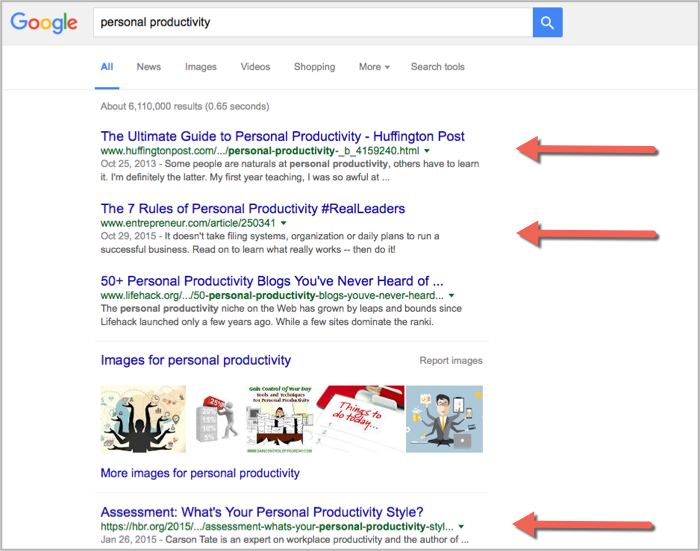

At this stage your spreadsheet should be filling up nicely with a whole bunch of interesting articles on this topic. And because they have ranked well in a Google search, it’s highly likely that they have plenty of backlinks.
Step 2: Uncover the linkers
Now that you have a list of articles it’s time to find the people that linked to them. To do this I use BuzzSumo, but you could use any number of tools like Moz, ahrefs or Majestic. Navigate to your tool of choice armed with the first of these URLs. If it’s BuzzSumo, click on the “Backlinks” button to discover who has linked to this article:
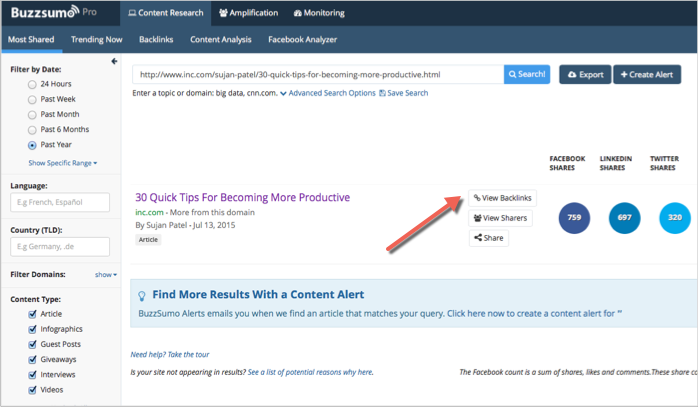
You will see a list of articles that have linked to this content.
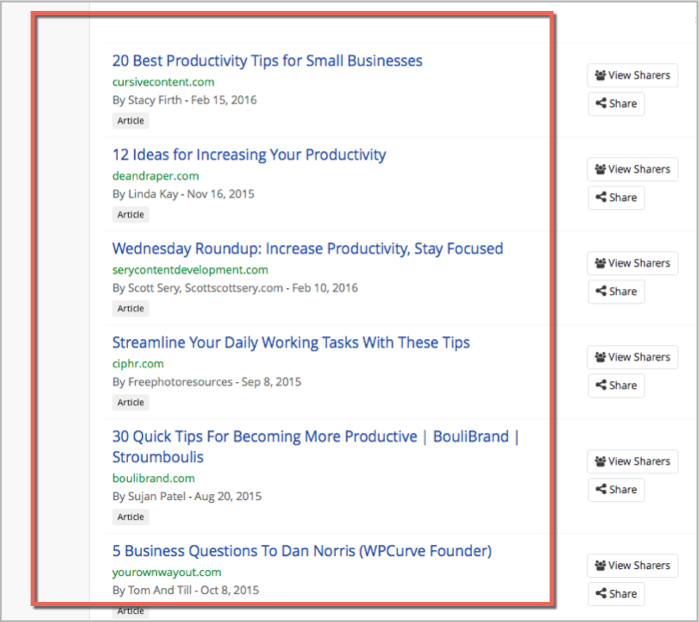
Step 3: Get their contact information
Once you know who has linked to these articles in the past, you need to find their contact information. This requires a bit of grunt work, but it will be worth it in the end.
The most important information to capture at this stage is the name, website they linked from, the name of their article and their email address.
To find their email address, you may need to do some digging. But “Any Mail Finder” can save you a whole bunch of time with this. Save their details into a spreadsheet so you can contact them later on.
Step 4: Rinse and repeat
Repeat steps 2 and 3 for all the other articles in your spreadsheet. It might seem time consuming, but the more backlink prospects you gather at this stage, the better your results will be. It’s a numbers game!
Group 2: Guest bloggers
Guest bloggers are authors who regularly write for high traffic and well respected online publishing platforms in your industry.
They are always on the look out for relevant, high quality content they can reference and LINK to in their articles. That’s why they are the perfect candidate for amplifying the reach of your content and getting more backlinks. Here is how you find guest bloggers worth contacting:
Step 1: Find sites that accept guest contributions
To find quality guest bloggers, first you need to find quality sites.
To do so you want to discover 10-15 sites that are closely aligned to your topic that accept guest contributors. Before you start looking for sites, it’s important to define what a quality site actually is.
Here are some criteria:
- They accept guest blogs: This may seem like a silly criteria, but a lot of sites don’t accept guest blogs.
- They allow external links within posts: Remember you are looking for opportunities where bloggers can potentially link back to your content, so including a relevant link on the website is important. Lots of websites don’t like authors to include external hyperlinks. Have a look at some other guest posts on the websites you find and look for links like this…
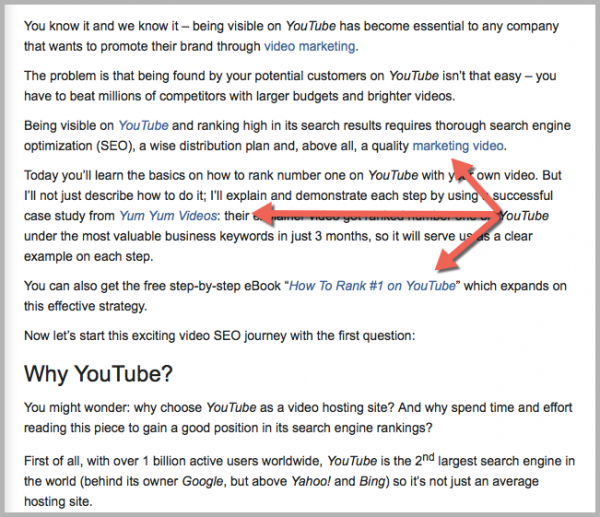
- They get a lot of social shares and comments on their posts. One quality factor you should consider when looking for sites is engagement. Check out the social media shares and comments section to see how much engagement their posts get.
- Respected people in your industry have blogged their before. Who do your audience respect? Find out where they are contributing, these are the type of sites you will want to find other guest bloggers from. Because on top of getting a link, you will build up some sweet social proof too.
- They have a respectable domain authority. “Quality” backlinks is what you want, so make sure the sites you choose have credibility with Google. You can use the Moz Chrome plugin to figure out any domains authority ranking, anything over 25-30 is worth going for but the higher the better.
Ok so you know what a quality site looks like, now you need to go and find them for your topic.
There are 3 places you can discover these sites for specific topics:
- Ask your audience. Where do they read information about your industry? What are their go-to sites? Who do they think are the most respected sources?
- Search on AllTop using your keywords. AllTop is a directory of publishing sites segmented up into topic area. Just enter a keyword into the search bar at the top of the browser and get a list of potential sites in your industry. I’ve searched for “Real Estate'”as an example in this screenshot. You may want to search for multiple terms to find the most appropriate sites.

- Search Google using your keywords + “Write for us” or “Writing guidelines”
Those three methods will help you gather together a big list of potential sites… Now it’s time to find their regular contributors.
Step 2: Pinpoint regular guest bloggers
Once you have a list of quality sites that accept guest contributions, next you’ll want to find the authors who contribute their regularly. This info will usually be at the bottom of blog posts. Here is an example from Conversion XL:
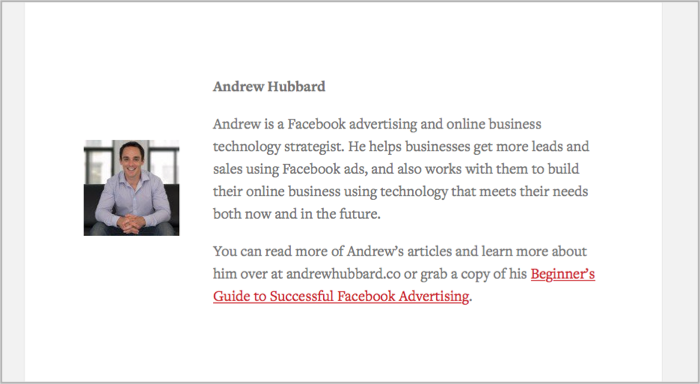
The trick is to spot people that don’t look like employees of the site, that have published more than one blog post. The easiest way to do this is to click on their name, just like this example from the Content Marketing Institute:
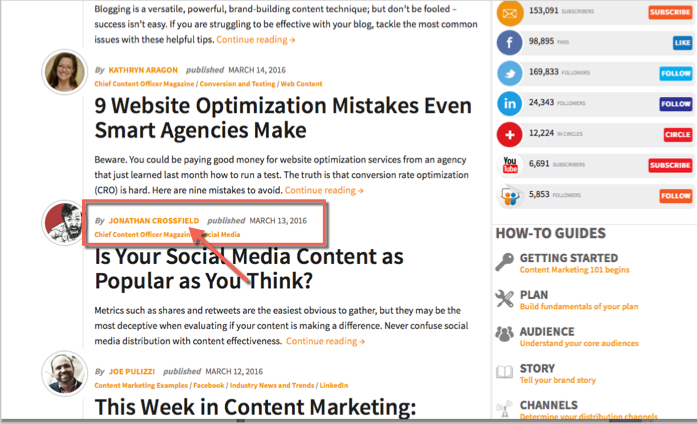
And you will see all their posts for the site, just like you do for Jonathan Crossfield’s below:

The really cool thing about building relationships with guest bloggers is they usually write for more than one site. If you can nurture a relationship with these people it could be your ticket to several more high quality backlinks.
Step 3: Get their contact information
Just like before, capture their contact information and some extra bits and pieces so you can personalize your outreach efforts.
Group 3: Round up authors
Content Roundups are a regular collection of the “Best Content” from around the web on a specific topic. Something like this from Matthew Woodward:

They are a common way for bloggers to add value to their own audience, as well as build relationships with the authors of the articles they mention in the roundup.
The people who collate these roundups as potential linkers, because they are willing and likely to send you a link if you have a relationship with them and your content is high quality.
Here’s how to find some content roundups in your industry:
Step 1: Find round-up posts in your industry
To get your content featured in one of these roundups, the first step is to find them. To do so, go to a Google search and mess around with some of the following phrases:
- Weekly or monthly roundup + your keyword
- Weekly or monthly mashup + your industry
- Best content on + your keyword
Here is an example for personal development:
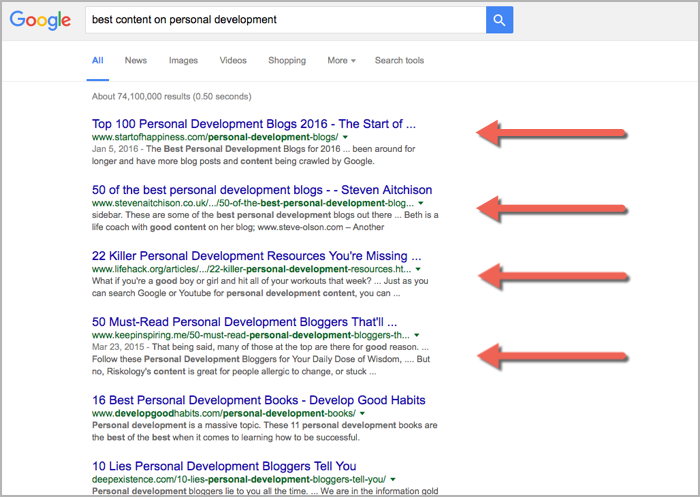
Thanks to Ana Hoffman for doing the thinking behind these search hacks!
Step 2: Get the author’s contact information
Once you have found a few relevant content roundups; capture the author name, contact information and any other information you can get to personalize your outreach message.
Getting these people to backlink to your content
I won’t go into conducting outreach, but before you can ask these people for a link, you need to get on their radar and initiate reciprocity.
In social psychology, reciprocity is a social rule that says we should repay, in kind, what another person has provided us. That is, people give back the kind of treatment they have received from you. This concept is a core ingredient for effective backlink outreach.
Before you reach out to these people you need to build a relationship – that’s of course if you want a better return on effort. Basically, the earlier you start to build these relationships and the more generous you are now, the more effective your outreach efforts will be later.
Here are some things you could be doing to begin earning trust and credibility with these backlink prospects:
- Share their content. For example, Twitterfeed is a tool I use to automatically share the new blog posts of people I consider to be influencers or backlink prospects. Here it is setup for Ian Cleary’s Razor Social blog;
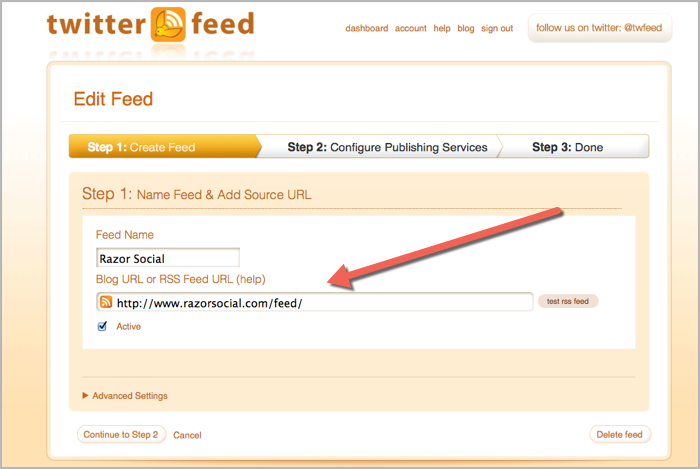
- Sign up for their mailing list and hit reply.
- Engage on social networks. Like this Tweet I’ve got on a recurring schedule for Cody Lister.
- Place a review of their podcast or book.
- Setup RSS feeds of their blog and regularly comment on new articles. Feedly is great for this;
- Buy their product and offer a testimonial.
- Be the matchmaker. Tee them up with someone they would want to meet. If they are a guest blogger, it’s probably other guest posting opportunities.
- Conduct pre-outreach. Good ‘ol permission marketing is still one of the best tactics going around… Ask them if it’s ok to do them a favour, then do it.
Conclusion
SEO is not getting any easier… But that’s a good thing, because it means that those of us who are creating high quality content will win in the end. If you take the time to properly research content opportunities, create something worthwhile and then build relationships with the people I have mentioned in this blog post, you will see positive results with your search rankings.
But don’t jump the gun. Relationships are really the key to all of this link building and SEO stuff, and don’t underestimate how long it can take to build them. If you’re patient; the trust, credibility and connections you build from this process will go far beyond a bit of search engine traffic. It will begin to form the foundations of your business.
No it won’t happen over night – so you need to persist. But most people give up way too early and miss all the rewards from the hard work that content and b2b marketing presents in the short term.
*This post was originally published on Blogger Sidekick.



